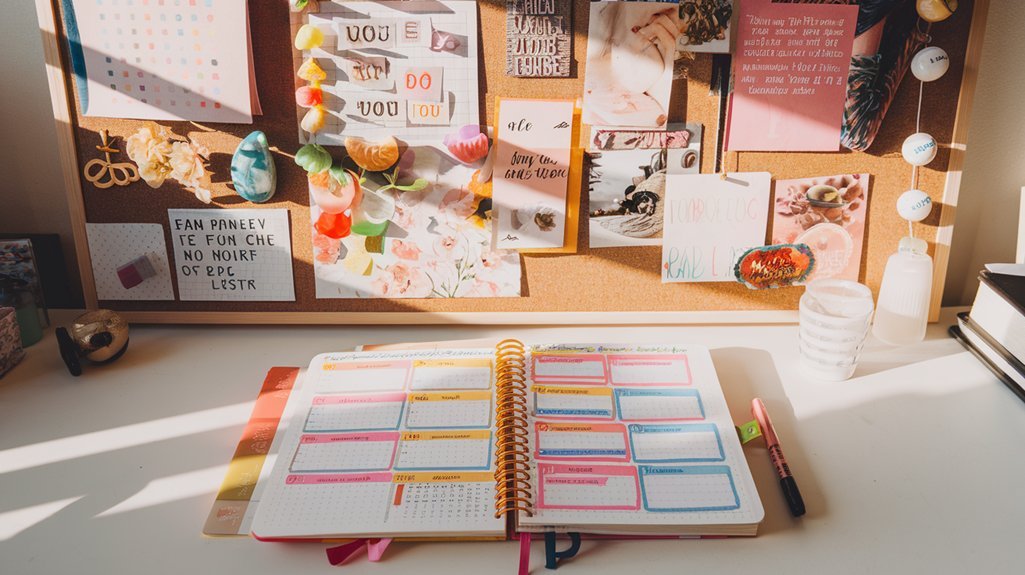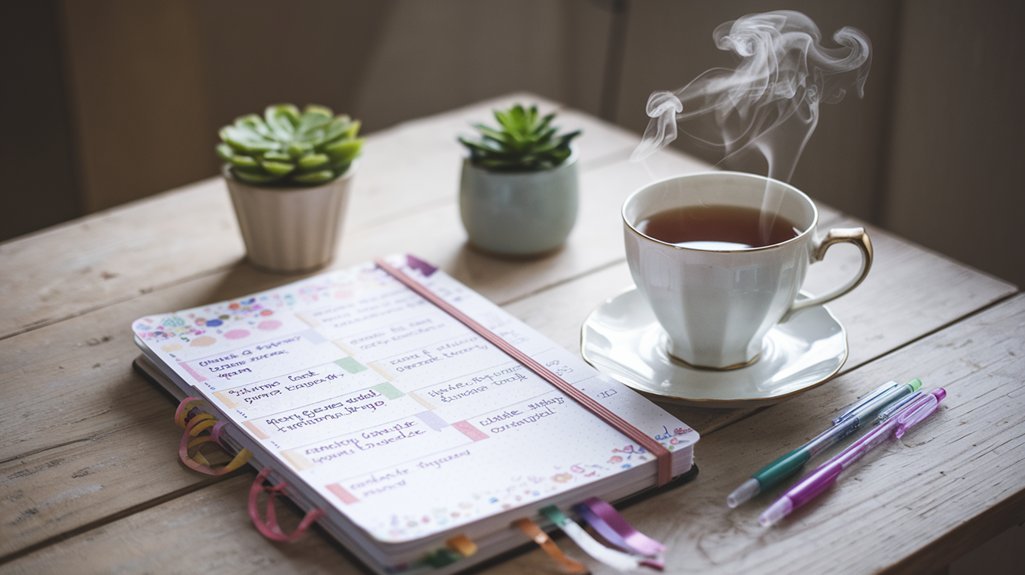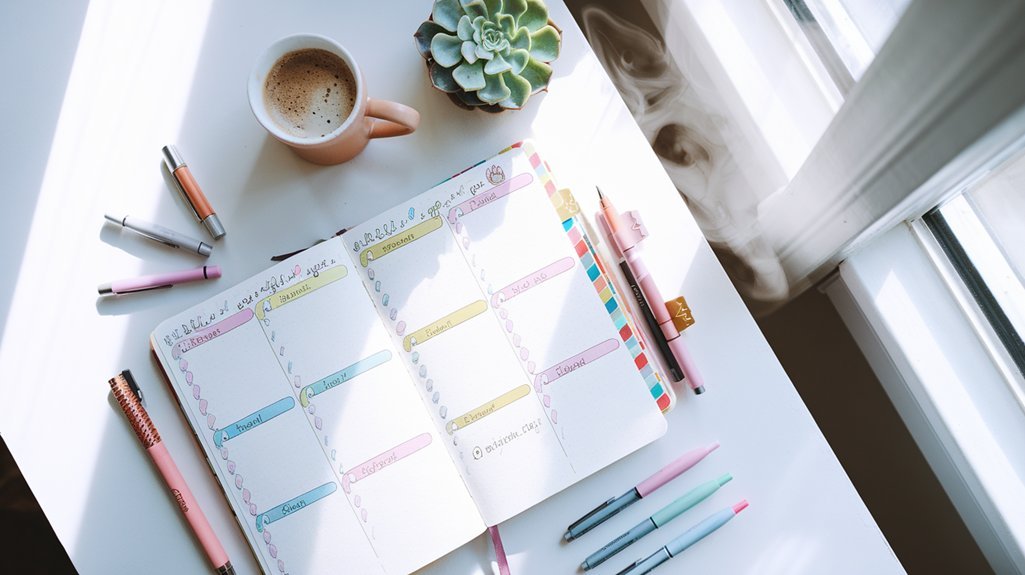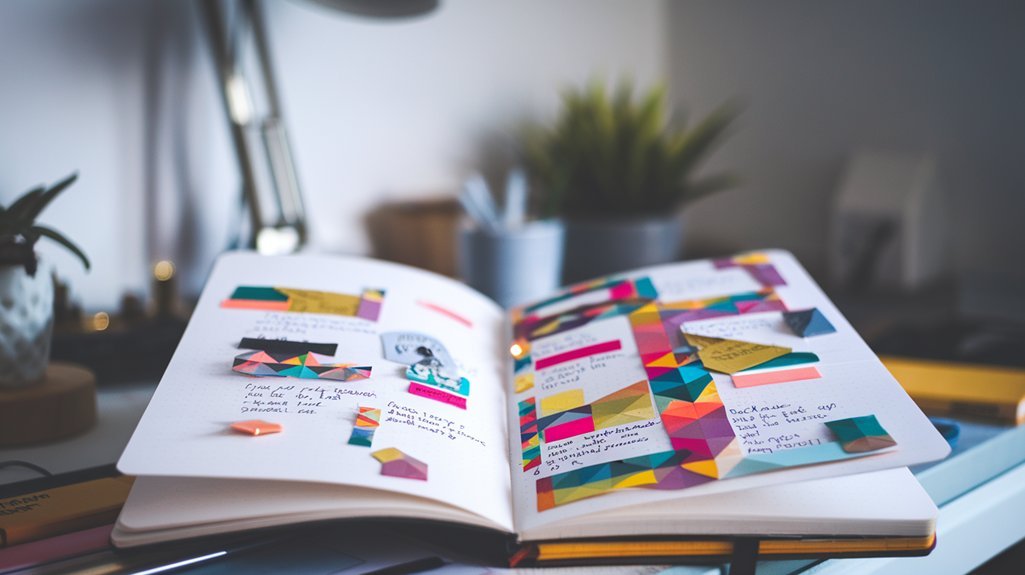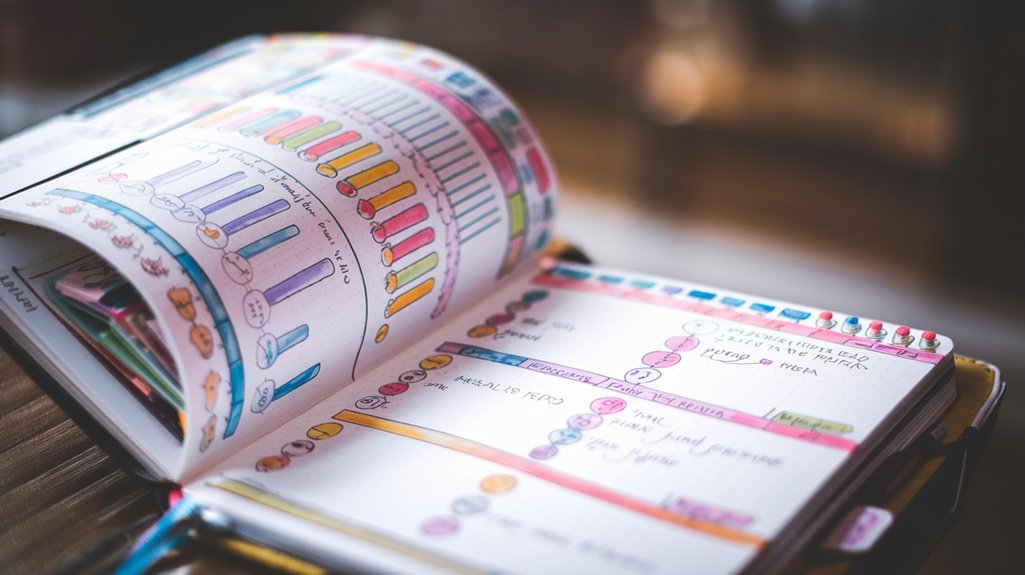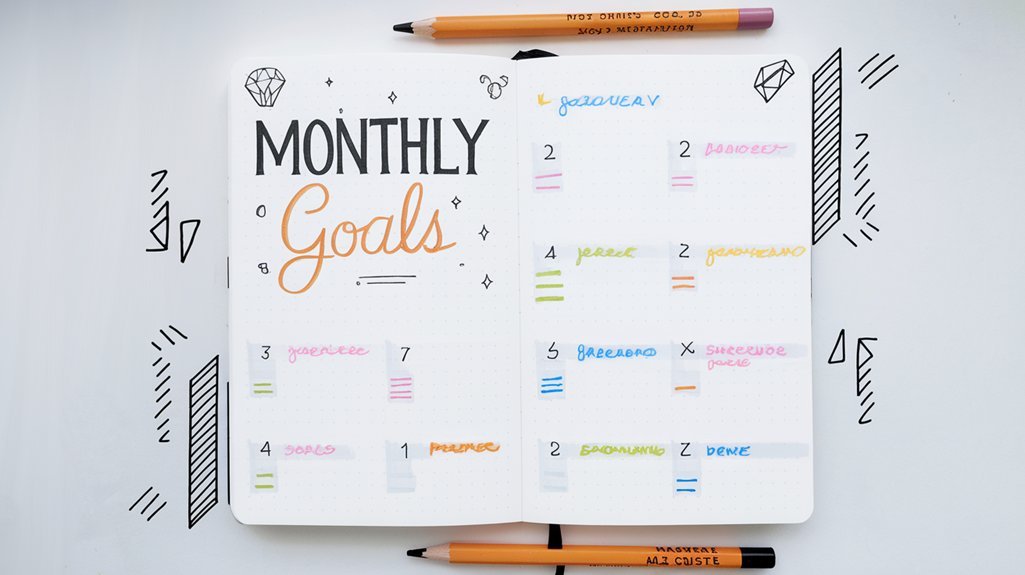Bullet journal vision boards harness the brain's remarkable ability to process visual information 60,000 times faster than text. By combining systematic organization with emotional imagery, these boards activate both analytical and creative neural pathways. The physical act of handwriting goals strengthens memory retention and commitment, while regular visual exposure triggers the reticular activating system to recognize opportunities. Through scientifically-proven cognitive processes, vision boards transform abstract dreams into actionable achievements – and understanding the mechanics behind this transformation reveals even more powerful ways to succeed.
The Science Behind Visual Goal-Setting
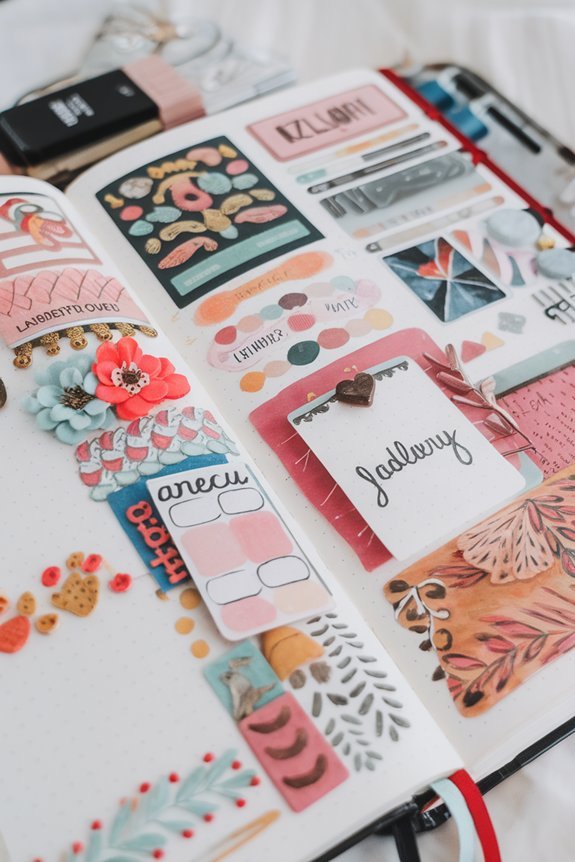
Three key psychological principles explain why visual goal-setting through bullet journaling produces measurable results. First, the brain processes visual information 60,000 times faster than text, making vision boards highly effective for memory recall and goal internalization. Second, regular exposure to visual representations triggers subconscious activation, programming the mind to recognize and pursue opportunities aligned with documented objectives.
The third principle involves the reticular activating system (RAS), a neural network that filters incoming information based on what the brain deems important. When individuals create vision boards in their bullet journals, they effectively train their RAS to focus on goal-relevant opportunities. This selective attention mechanism helps transform abstract aspirations into concrete achievements.
These scientific foundations demonstrate why the combination of intentional visualization and systematic bullet journaling creates a powerful catalyst for personal transformation, leveraging the brain's natural tendency to pursue visually reinforced goals.
Key Components of an Effective Bullet Journal Vision Board
Creating a powerful bullet journal vision board requires several essential elements that work together to maximize its effectiveness. The thoughtful combination of spatial organization and visual triggers helps transform abstract goals into tangible action steps.
| Component | Purpose |
|---|---|
| Clear Headlines | Defines specific goal categories |
| Images/Photos | Creates emotional connection |
| Action Steps | Lists concrete tasks |
| Timeline | Establishes deadlines |
| Progress Trackers | Monitors advancement |
A well-structured vision board incorporates these elements while maintaining clean, uncluttered spaces that allow the mind to focus. The arrangement should flow naturally, guiding the eye from big-picture aspirations to detailed implementation strategies. Color coding and strategic placement of visual triggers enhance recall and motivation, while dedicated spaces for reflection enable users to adjust their approach as needed. When these components align properly, the vision board becomes a dynamic tool that bridges the gap between inspiration and achievement.
Left Brain Meets Right Brain: The Perfect Balance
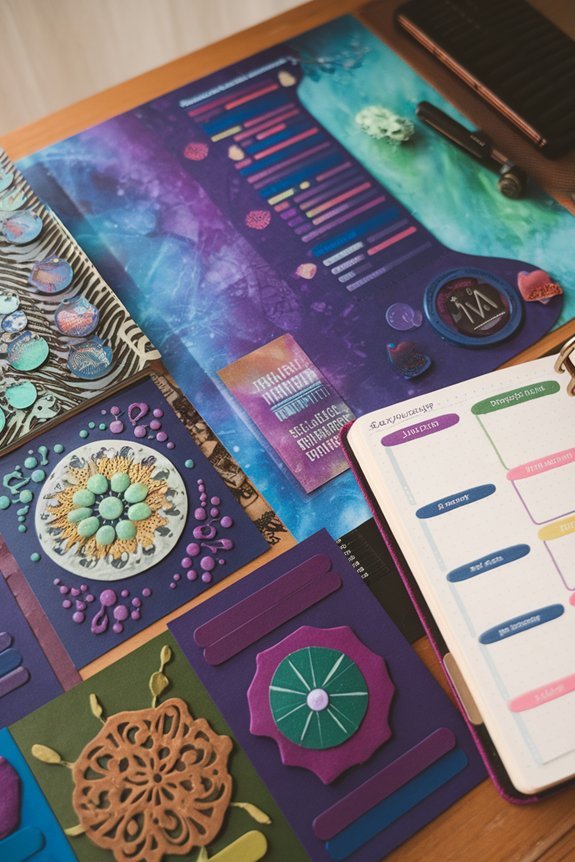
The fusion of analytical and creative thinking makes bullet journal vision boards uniquely powerful tools for goal achievement. By combining structured planning with visual inspiration, these boards create cognitive balance that engages both hemispheres of the brain simultaneously.
The left brain appreciates the systematic organization, lists, and measurable metrics that bullet journaling provides. Meanwhile, the right brain responds to the colorful imagery, artistic elements, and emotional resonance of traditional vision boarding. This integrated thinking approach creates a more complete neural pathway for manifesting goals and desires.
When users engage in both logical planning and creative visualization, they activate multiple mental processes that reinforce their objectives. The structured format helps break down abstract dreams into actionable steps, while the visual components maintain emotional connection and motivation. This harmonious blend of left and right brain functions creates a more effective goal-setting system than either approach could achieve alone.
Psychological Benefits of Handwritten Goals
Research consistently demonstrates multiple psychological advantages of handwriting goals compared to digital typing. Studies show that the neurological writing effects activate regions in the brain associated with learning, memory, and emotional processing. This deeper engagement creates stronger neural pathways, making handwritten goals more likely to be remembered and achieved.
| Mental Benefits | Physical Benefits |
|---|---|
| Enhanced memory retention | Improved motor skills |
| Greater emotional connection | Better hand-eye coordination |
| Increased focus | Reduced screen fatigue |
| Stronger goal commitment | Stress reduction |
The handwritten goal flexibility allows for personalization and creative expression that digital formats cannot match. When individuals write their goals by hand, they process information more thoroughly and develop a stronger emotional connection to their objectives. This heightened engagement leads to better goal internalization and increased motivation to achieve desired outcomes. The physical act of writing also provides a meditative quality, helping reduce anxiety while enhancing focus and clarity of purpose.
Creating Neural Pathways Through Visual Planning

When individuals engage in visual planning activities, their brains forge powerful new neural connections that strengthen both creativity and goal achievement. The process of neuroplasticity through visualization enables the mind to create lasting pathways that support the manifestation of desired outcomes. Through sensory stimulation in planning, people activate multiple brain regions simultaneously, enhancing their capacity for focus and implementation.
- Creating vision boards stimulates the visual cortex, improving memory retention of goals
- Drawing and sketching plans activates motor skills linked to enhanced learning
- Color-coding systems trigger emotional responses that reinforce motivation
- Spatial arrangement of goals on paper strengthens organizational thinking
- Regular visual planning exercises build sustainable cognitive patterns
This scientific approach to visual planning transforms abstract ideas into concrete neural frameworks. As these pathways strengthen through consistent practice, individuals experience improved clarity, heightened motivation, and accelerated progress toward their objectives. The combination of artistic expression and structured planning creates a powerful foundation for lasting behavioral change.
The Role of Color Psychology in Vision Boards
Each color choice in vision board creation activates distinct psychological responses that can amplify goal achievement. The strategic use of color vibrancy and calming hues can transform a simple bullet journal into a powerful tool for manifestation and personal growth.
| Color | Psychological Effect | Best For Goals Related To |
|---|---|---|
| Red | Energy & Passion | Fitness, Career Drive |
| Blue | Trust & Clarity | Communication, Learning |
| Green | Growth & Balance | Finance, Health |
| Yellow | Optimism & Focus | Creativity, Personal Joy |
Research shows that incorporating specific colors into vision boards enhances their effectiveness by aligning with the brain's natural response patterns. For example, using calming hues in areas dedicated to meditation goals creates a sense of serenity, while bright, energetic colors can stimulate motivation for action-oriented objectives. This intentional color selection process helps strengthen the connection between visual representation and goal achievement, making vision boards more than just aesthetic tools.
Tracking Progress: Measurable Results and Accountability
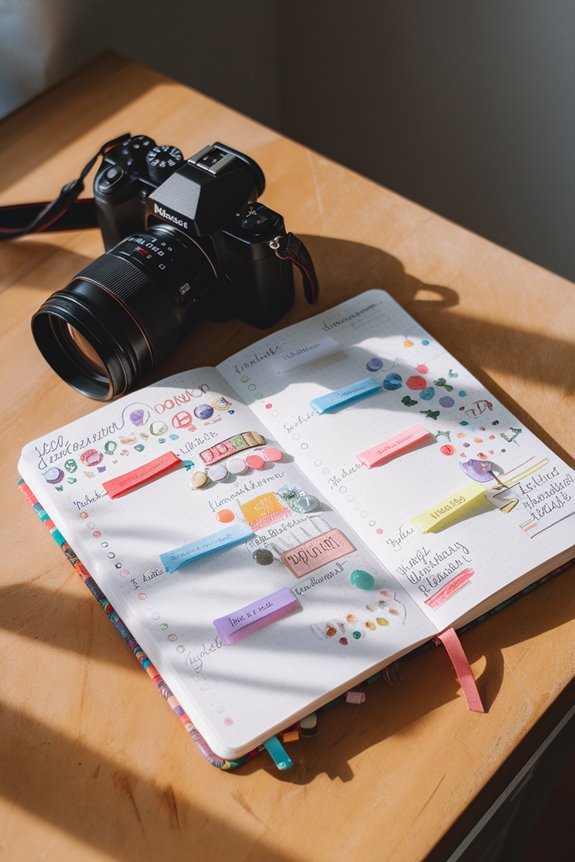
Transforming vision board dreams into reality requires a systematic approach to progress tracking and accountability. The bullet journal format provides an ideal framework for monitoring quantifiable milestones and maintaining task accountability through dedicated tracking pages.
Effective goal achievement demands structured tracking methods – bullet journaling transforms abstract vision board dreams into concrete, measurable progress.
- Create weekly check-in spreads to monitor small victories and adjustments
- Implement a habit tracker specifically aligned with vision board goals
- Use progress bars or milestone charts to visualize advancement
- Schedule monthly review sessions to assess movement toward objectives
- Document both successes and setbacks to identify patterns
Habit Formation Through Daily Visual Reminders
Incorporating vision boards into a bullet journal creates powerful daily triggers for habit formation, as the consistent visual exposure reinforces desired behavioral changes. When integrated with mindfulness meditation, these visual cues activate subconscious motivation, making habit development more automatic and sustainable.
| Visual Element | Habit-Forming Impact |
|---|---|
| Goal Images | Triggers dopamine response |
| Progress Trackers | Builds momentum |
| Affirmations | Strengthens neural pathways |
| Color Coding | Enhances emotional connection |
| Success Symbols | Reinforces positive behavior |
Research shows that individuals who maintain daily visual contact with their goals are 42% more likely to achieve them. The bullet journal format allows for strategic placement of vision board elements throughout daily planning pages, ensuring multiple touchpoints throughout the day. This repeated exposure, combined with intentional reflection, creates a feedback loop that transforms aspirational behaviors into ingrained habits. The process activates both conscious and unconscious mind processes, accelerating the journey from intention to automatic behavior.
Customizing Your Board for Maximum Impact

The art of customizing a bullet journal vision board combines strategic color choices, thoughtful layout planning, and meaningful personal symbolism to create a powerful motivational tool. Implementing color psychology principles enhances emotional connections to goals, while carefully designed spaces maximize both functionality and visual appeal. Personal symbols and icons serve as shorthand for complex ideas, making the board both efficient and deeply meaningful to its creator.
Color Psychology in Planning
When crafting a bullet journal vision board, colors serve as powerful psychological triggers that can amplify manifestation efforts and boost motivation. Understanding color associations and emotional responses helps creators design layouts that resonate with their subconscious mind and reinforce their goals.
- Red stimulates energy and passion, ideal for fitness and career aspirations
- Blue promotes calm and focus, perfect for educational and personal growth goals
- Green represents abundance and growth, suitable for financial planning
- Yellow enhances creativity and optimism, excellent for artistic projects
- Purple embodies wisdom and luxury, beneficial for spiritual development
Research shows that intentionally chosen colors can substantially impact goal achievement by creating stronger neural connections between objectives and their visual representations. This strategic approach to color selection transforms a simple planning tool into a powerful catalyst for personal transformation.
Layout and Space Design
Strategic layout design stands as the cornerstone of an effective bullet journal vision board, transforming scattered aspirations into a cohesive roadmap for success. Through intentional space organization, creators can establish clear visual hierarchies that guide the eye naturally through their goals and dreams.
Layout optimization plays a pivotal role in maximizing the board's impact. By dividing the space into purposeful sections, users create distinct areas for different life aspects while maintaining visual flow. The strategic placement of images, affirmations, and milestone markers enhances focus and retention, making goals feel more achievable and immediate.
Effective space utilization also allows for future additions and updates, ensuring the vision board remains a dynamic tool rather than a static display. This flexibility supports personal growth while maintaining the board's motivational power.
Personal Symbols and Icons
Personalized symbols and icons serve as powerful visual anchors in bullet journal vision boards, creating an intimate language that speaks directly to each creator's subconscious mind. Through symbolic representation, individuals forge deeper connections with their goals and aspirations, making their vision boards more meaningful and effective.
- Stars and celestial symbols for aspirational achievements and dreams
- Arrows indicating direction, progress, and forward momentum
- Hearts representing emotional well-being and relationships
- Mountains symbolizing challenges and personal growth
- Simple geometric shapes for balance and structure
Visual imagery that resonates on a personal level strengthens the impact of vision boards, making goals feel more attainable. When creators develop their own system of symbols, they establish a unique visual vocabulary that enhances their journaling practice and reinforces their commitment to achieving desired outcomes.
Success Stories and Research-Backed Results

Numerous success stories from bullet journal vision board practitioners demonstrate the tangible impact of this creative goal-setting method. Real life testimonials consistently show improved goal achievement rates, with practitioners reporting success in areas ranging from career advancement to personal development and financial targets.
Empirical studies support these anecdotal findings. Research from the Dominican University of California found that individuals who write down their goals are 42% more likely to achieve them, while a Harvard Business study revealed that written goals correlate with markedly higher income levels. The combination of visual elements and written intentions in bullet journal vision boards activates multiple cognitive processes, enhancing commitment and focus.
The scientific evidence aligns with practitioner experiences, showing that the act of creating and regularly engaging with a bullet journal vision board strengthens neural pathways associated with goal-oriented behavior and motivation, leading to measurable improvements in goal attainment.
Conclusion
Bullet journal vision boards aren't just pretty notebooks – they're revolutionary mind-hacking tools that can literally rewire your brain for success. By combining the supernatural power of visualization with the unstoppable force of handwritten intention, these boards transform impossible dreams into inevitable victories. Those who harness this game-changing blend of art and science don't just reach their goals – they absolutely demolish them, creating a life that once seemed unimaginable.

